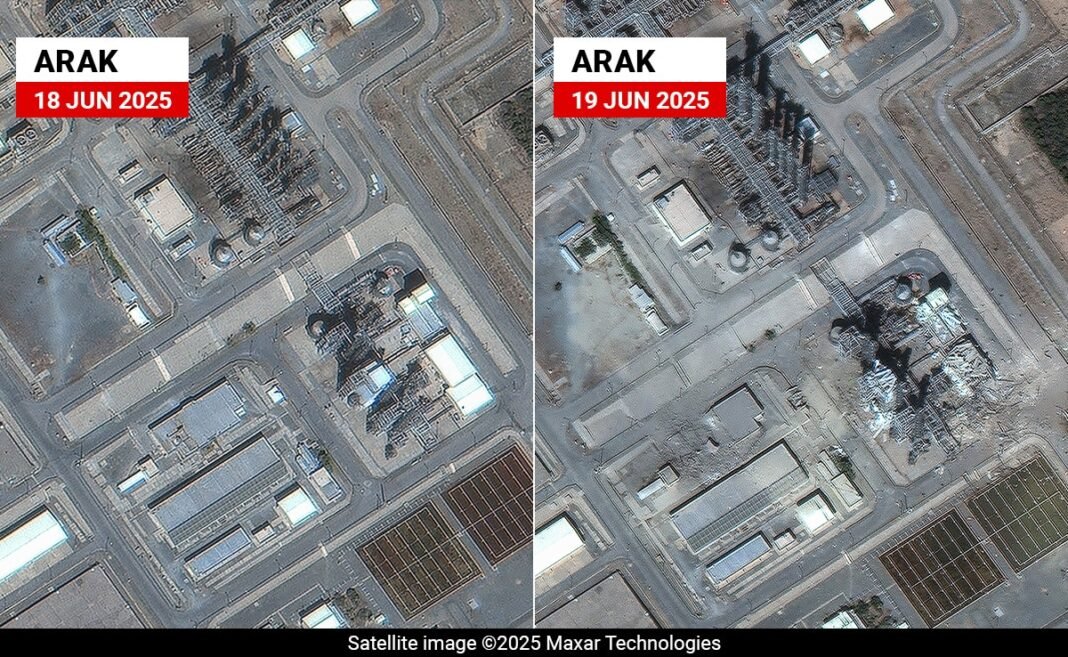In June 2025, rising tensions between Israel and Iran took a violent turn as Israeli air strikes targeted Iran’s controversial Arak reactor. With satellite imagery confirming structural destruction, the event marks a new chapter in nuclear geopolitics and underscores the frailty of diplomatic deterrence in volatile regions.
Satellite Proof of Israeli Strike
If the world talks of nuclear tensions, the focus is often on Iran. But in June 2025, the tension went physical, violent and public. Israel carried out a campaign of air strikes on critical Iranian nuclear facilities, including Arak’s heavy water reactor, or Khondab. The long-expected attack now has satellite-confirmed visuals that show severe damage in a facility that was considered at the heart of Iran’s nuclear aspirations.
But high-definition photos taken June 19 by Maxar Technologies provide indisputable evidence: the upper part of the Arak reactor dome has fallen in, and nearby structures including distillation towers were visibly torn apart. While Iranian officials acknowledged that “missiles” had hit the complex, they initially concealed the full extent of the damage. These satellite pictures now provide the proof that many in the know suspected – Israel’s accurate strikes caused structural damage to one of Iran’s most watched nuclear sites.
What Is the Arak Reactor?
The Arak reactor is not new to scandal. This heavy water reactor is some 250 kilometers southwest of Tehran and was initially designed to have a plutonium potential, a nuclear weapon-usable material. Iran has long maintained that its nuclear program is strictly for peaceful purposes, says Arak, like other sites, is alleged to be for energy and research. But the technical details have always sounded fishy.
Unlike ordinary light water reactors that use regular water as a neutron moderator and that need enriched uranium fuel, heavy water reactors such as Arak use deuterium oxide (heavy water). This makes them operable with natural uranium and allows production of plutonium. These days, even if that amount was just small, any such facility would, in turn, be a target for any government worried about nuclear proliferation.
Iran began work on Arak in the 1990s, after it became clear that it would be unable to purchase a heavy water reactor from sources outside the country. The move came after Iran’s decision-making leadership made a strategic decision to continue with nuclear capability following the trauma of the Iran-Iraq war (1980-88). Although the plant was never fully operational, its design had made it a focus of international concern.
The Nuclear Deal from 2015 and the Fate of Arak
The Arak site was a sticking point in the talks that eventually resulted in the 2015 agreement on Iran’s nuclear program, known as the Joint Comprehensive Plan of Action (JCPOA). Acknowledging that Arak had the potential to make weapons-grade plutonium, the JCPOA forced Iran to scrap many of the reactor’s components. This redesign was intended to cap the plant’s production and stop the buildup of plutonium in nuclear weapon-usable amounts.
As part of the agreement, Iran also committed to fill the core of the reactor with concrete, making it impossible to use. This was a symbolic and strategic move – it illustrated Iran’s good faith, it helped to address Western anxieties over weaponization, and, to an extent, it showed that Iran was committed to peaceful development.
But that all changed dramatically in 2018 when former US President Donald Trump withdrew from the JCPOA on his own. The collapse of the deal left a void of trust and oversight. In 2019, the head of the Iranian Atomic Energy Organisation, Ali Akbar Salehi, said Iran acquired duplicate parts without knowledge of powers that were monitoring it to build its new machines. On state television, Salehi acknowledged that these parts could permit the country to reconstruct the reactor core if necessary. Diplomat circles were shaken by his declaration.
Since then, the International Atomic Energy Agency (IAEA) has found it increasingly difficult to monitor the site. Officials from the agency have acknowledged they lost “continuity of knowledge” about the design of the Arak reactor and about the quantities of Iran’s heavy water stocks, which are keepers of nuclear clues, because of limitations on inspections. The loss of transparency was fertile ground for speculation, and fear only grew year on year.
Also read, Donald Trump to decide in two weeks whether US will strike Iran: White House
Israel’s Calculated Strike
Those fears were not quelled, in June, by diplomacy but by force of arms. Israel’s air strike in Arak was not an isolated mission. In the course of one week Israeli forces also targeted Natanz, Isfahan, Karaj and Tehran. But the hit on Arak was the most symbolic.
The Israel Defense Forces posted video footage of precision guided munitions striking the reactor dome, followed by a burst of fire and smoke. The demolition of the dome, later verified by Maxar satellite imagery, dovetailed neatly with Israel’s stated aims. The raids – said to aim to “target the plutonium producing section of the Khondab reactor, to preclude its refurbishment and its possible eventual use for military nuclear purposes” – were first announced by state outlets and were later confirmed by US officials.
These were not random bombings. Israel’s strikes seem to be aimed at making the site permanently inoperable without causing a radiological catastrophe. This objective was fulfilled to some extent because the reactor had not – and never had been – fueled in, or gotten into, operation.
The IAEA subsequently reported that there was no release of radiation at that site. But the agency warned soon after the strike: This was a dangerous precedent. And of course, military strikes against nuclear facilities, functioning or not, add an element of risk that cumulatively cannot be discounted. In the Middle East The IAEA had a “serious concern” against legitimizing such actions.
Iran’s Silence and Satellite Truth
Iran’s first reaction to the attack was restrained. Officials said the Arak complex had been hit by “projectiles,” but did not elaborate on the damage. Those whispers, however, were shattered by satellite images. The Maxar photos provided the clearest view yet that the top of the dome had collapsed, and several key pieces of infrastructure near the main reactor had also been hit, including a turbine hall.
But perhaps the reason for Iran’s muted reaction is by design. With this reluctance to directly address the full extent of the damage, Iranian decision makers would be spared public embarrassment and could still hope to maintain some psychological deterrence. Having one of their key nuclear sites laid to waste by enemy action would deal a blow to morale, both at home and abroad.
Meanwhile, Iran’s silence leaves open questions about what was actually in the reactor at the time of the strike. Although the IAEA said there was no radiological release, the agency has been denied access to the site for years. The real state of the reactor’s preparedness is the subject of a heated debate among intelligence analysts and non-proliferation specialists.
Global Ramifications
The Israeli strike on Arak deepens a supremely volatile geopolitical mix. The West and Iran still have uneasy relations. The failure of the JCPOA and the lack of an alternative has created a vacuum. At the same time, regional powers like Israel are often driven to act on their own to meet what they view as existential threats.
The strike should be a wake-up call for the international community. What it shows is how fast the thin patina of diplomatic control over nuclear tensions can crumble. The failure of the reactor in Arak to go online may have averted catastrophe this time, but next time a strike may not be so fortunate.
The IAEA’s concerns about military strikes on nuclear infrastructure aren’t just petty bureaucratic quibbling. They also reflect the actual risk of accidental release of radiation which could in turn spread the conflict and undermine international nuclear governance.
This also adds to the pressure on any potential efforts to bring back the nuclear deal. Negotiations that diplomats had hoped to quietly restart are now confronted not just by enrichment levels and centrifuge counts, but also destroyed infrastructure and military confrontations.
A Reactor That Stands for More Than Science
More than nuclear science The Arak reactor has long represented more than nuclear science. To Iran, it is a symbol of sovereignty, to Israel an existential threat, to global diplomacy a bargaining chip. Its history is a list of edgy encounters – from furtive parts orders to sabotage, redesigns, inspections and, eventually, demolition.
The latest strike underscores that there is just about no more diplomatic time. Without new talks or more rigorous international verification, they suggest, the Middle East might go on slouching toward a day when deterrence is not based on treaties but on two hitherto equally undesirable possibilities.
Conclusion
The Israeli bombing raid on Iran’s Arak heavy water reactor is so much more than a military assault. It is a battleground in the larger war over nuclear capabilities, regional power dynamics and international diplomacy. With visible damage confirmed by satellite photos and officials from all sides expressing caution, the event serves as a reminder of a deeper reality: nuclear facilities, even sleeping ones, are valuable targets in geopolitical streets rife with protest and violence.
The damage to Arak has consequences that are broader than simply in Iran, or in Israel, but have wider effects on international security. As the world wrestling with the aftermath, one truth endures: when diplomacy vanishes, destruction is all that rushes in. Whether this was a one-off warning or the beginning of a new chapter in the Iran-Israel confrontation, only time will tell. But the images of the dome in Khondab reduced to rubble will outlast the strike that brought it down.
FAQs
- What is the Arak reactor used for?
Originally designed as a heavy water reactor, Arak had the potential to produce plutonium, raising concerns over its possible use in nuclear weapons programs. - Did the Israeli strike cause a radiation leak?
No, the IAEA confirmed that there was no radiation released, as the reactor had not been operational or fueled. - Why did Israel strike Arak now?
Israel likely acted to prevent Iran from refurbishing the reactor for potential military nuclear uses, especially amid reduced oversight post-JCPOA collapse. - What was Iran’s official response?
Iran initially downplayed the event, referring to “projectiles” but provided no detailed damage reports. Satellite images later revealed extensive damage. - How does this affect future nuclear negotiations?
It complicates diplomacy by introducing destroyed infrastructure and raises tensions, making return to agreements like the JCPOA even more difficult.
Reference
Satellite Images Show Massive Damage To Iran
Stay updated with all the latest news and insights – News Of US






